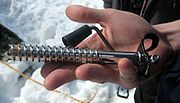
Ice screw
Encyclopedia

Climbing
Climbing is the activity of using one's hands and feet to ascend a steep object. It is done both for recreation and professionally, as part of activities such as maintenance of a structure, or military operations.Climbing activities include:* Bouldering: Ascending boulders or small...
on steep ice surface such as steep waterfall ice or alpine ice during ice climbing
Ice climbing
Ice climbing, as the term indicates, is the activity of ascending inclined ice formations. Usually, ice climbing refers to roped and protected climbing of features such as icefalls, frozen waterfalls, and cliffs and rock slabs covered with ice refrozen from flows of water. For the purposes of...
or crevasse rescue
Crevasse rescue
Crevasse rescue is the process of retrieving a climber from a crevasse in a glacier. Because of the frequency with which climbers break through the snow over a crevasse and fall in, crevasse rescue technique is a standard part of climbing education....
, to hold the climber in the event of a fall, and at belays as anchor points. Ice screws are made by several manufacturers. The various products available offer essentially similar functionality but typically offer subtle differences in design. For example, some ice screws come with one or more of the following: an in-built or separate ratchet mechanism to speed up placement, conical centre-hole to aid removal of ice cores, different lengths, different numbers of cutting teeth, different cutting angles, different surface finishes, different size hangers/clip holes. Price and durability are usually design considerations too, as a useable rack of ice screws will be a significant financial investment for many climbers. Titanium
Titanium
Titanium is a chemical element with the symbol Ti and atomic number 22. It has a low density and is a strong, lustrous, corrosion-resistant transition metal with a silver color....
ice screws, often made in the former Soviet Union using Cold War
Cold War
The Cold War was the continuing state from roughly 1946 to 1991 of political conflict, military tension, proxy wars, and economic competition between the Communist World—primarily the Soviet Union and its satellite states and allies—and the powers of the Western world, primarily the United States...
-era missile technology, were generally too brittle and so the majority of ice screws are made of chromoly steel
41xx steel
41xx steel is a family of SAE steel grades, as specified by the Society of Automotive Engineers . Alloying elements include chromium and molybdenum, and as a result these materials are often referred to as chromoly steel or CRMO...
.
The strongest and most reliable type of ice screws currently available are the modern tubular ice screws which range in lengths from 10 to 23 cm. The approximate strength rating on a modern tubular ice screw is around 7 kN, although it has been found that short ice screws in "good" real-world ice hold about 7-8kN, no matter what the fall factor
Fall factor
In climbing, using a dynamic rope, the fall factor f is the ratio of the height h a climber falls before the climber's rope begins to stretch and the rope length L available to absorb the energy of the fall....
or configuration is, according to research by Beverly and Attaway. The UIAA drop test uses a particularly taxing configuration for ice screws. That is, when multi-pitch lead climbing and the leader has only placed one screw (typically merely clipping one of the anchor screws) before climbing up a couple of meters and falling (i.e. fall factor
Fall factor
In climbing, using a dynamic rope, the fall factor f is the ratio of the height h a climber falls before the climber's rope begins to stretch and the rope length L available to absorb the energy of the fall....
1). The dynamic ropes used in climbing can mitigate failure of an ice screw by keeping the impact forces low, especially if using a new rope that has not had any previous falls. It is rare that an ice screw fails in fall factors of 1 or less, if placed in good ice (which is why it is so important to place a screw or other running belay soon after starting a pitch).
An older type of screw that is rarely used today is a pound-in ice screw. Instead of screwing these into the ice one would pound them in with a mountaineering hammer or a hammer from the ice tool, and then screw them out to remove them. The pound-ins have been largely replaced by modern tubular ice screws that are stronger and easier to use.
The subtle nuances of ice screw placement should be mastered before using them for climbing. Learn from a professional how to best protect yourself using ice screws.
The latest ice screws incorporate replaceable tips, thereby increasing the useful life of the screw and enhancing placements.
Placement
It was once thought necessary or beneficial for ice-screws to be place horizontally or more than horizontally (with the hanger up) for optimum hold. However, it has since been found experimentally that a screw place with the tip angled up often holds as well or better. This surprising result is thought to be due to the previously underestimated role of the threads in holding the screw in place. However, horizontal placements are usually recommended. Consult the manufacturers instructions.Some climbers use tape slings to "tie-off" long ice-screws that have not been fully screwed into the ice, to reduce the leverage of a fall, which might bend or break the screw. There is some risk that such slings may move and/or be slice by the screw's hanger. Some novel ice screws include a hanger that can be moved down the shaft, instead of using a sling. Placing a shorter screw is usually the preferred option, hence various lengths are available.

